Cucumbers grow from the seeds and are easy to maintain. You can grow them quickly from the seed or buy starter plants from the market. In both ways, you have to transplant the seedlings.
Cucumber plants can be transplanted if done carefully. Cucumber seedlings can be transplanted once they have developed their first true leaves and are strong enough to handle transplanting. Handling the plants gently and providing proper care after transplanting is important to ensure good growth.
Several things require consideration while transplanting the cucumbers. This article will teach you a step-by-step guide to transplanting the cucumbers and the preparation and care the seedlings need before and after transplantation.
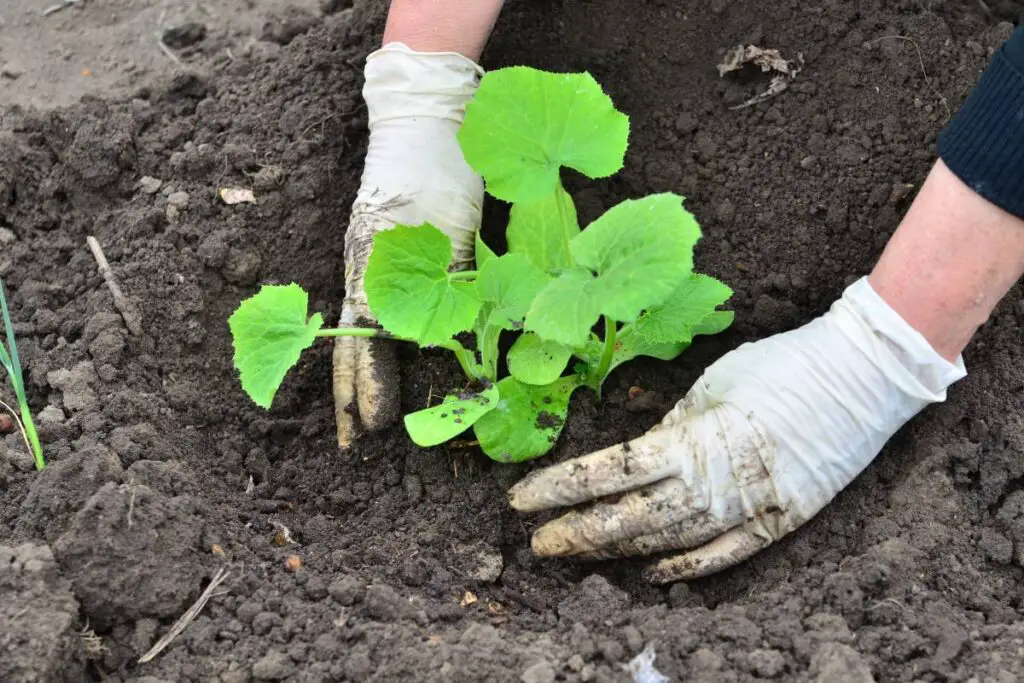
Understanding cucumber transplants
When a small plant or seedling emerges from a seed, it must be transplanted once it grows 2 cotyledon leaves and 2-3 true leaves.
They are around 2-3 weeks old.
You can either grow the transplants from the cucumber seeds in your home or buy the starters from the market.
In either case, you must transplant them.
You must transplant them directly into the ground or from one pot to another.
In most cases, the cucumbers are directly grown in the ground, so you do not have to transplant them.
But starting the seeds indoors allows you to have an early start.
If your region has a short growing season, this will be beneficial.
Also, you can grow them in controlled conditions without any stress.
While transplanting the seedlings, ensure not to disturb the roots at all.
Please remove the plant, and replant it straight in the desired location.
Read on to know more about the advantages of transplantations, things to consider, the process, and tips for successful transplantation.
Advantages and considerations of transplanting the cucumber plants
Whether you transplant the plants outside or from one pot to another, it gives you several benefits:
- While transplanting the cucumber plants outdoors, it receives adequate sunlight daily, which is essential for their overall growth and development.
- Outdoors in the garden, the cucumbers will have enough space for strong and extensive root growth, further supporting the whole plant.
- With a well-developed root system, the transplants will grow faster and healthy.
- By transplanting the cucumbers in the garden or larger pot, the plant will receive more moisture and nutrients than from the smaller pots due to the increase in the soil volume.
- Growing the seeds indoors controls their environment and keeps them from pests and diseases. Once the transplants become healthy, the risk of pests and diseases will reduce, and yields will increase.
- When you start the seeds indoors, you can transplant them when the weather is warm enough. This early start will give the cucumbers an extended growing season and early harvest.
Transplanting the seedlings or the starters from the pot to the ground or another big pot leads to improved root systems, healthy plants, better nutrient and moisture uptake, and sufficient sunlight.
While transplanting, consider a few things:
Make sure not to disturb the roots at all.
Keep the soil around the roots while transplanting.
The transplants stay in a controlled environment inside. So, before transplanting, remember to harden them off.
Transplanting will need some planning, like choosing the right time and location for transplant, planting them in the ground or pots, preparing the soil, maintaining the correct depth and spacing, choosing the right day, etc. Keep these things in mind before transplanting them.
Choosing the right time for cucumber transplanting
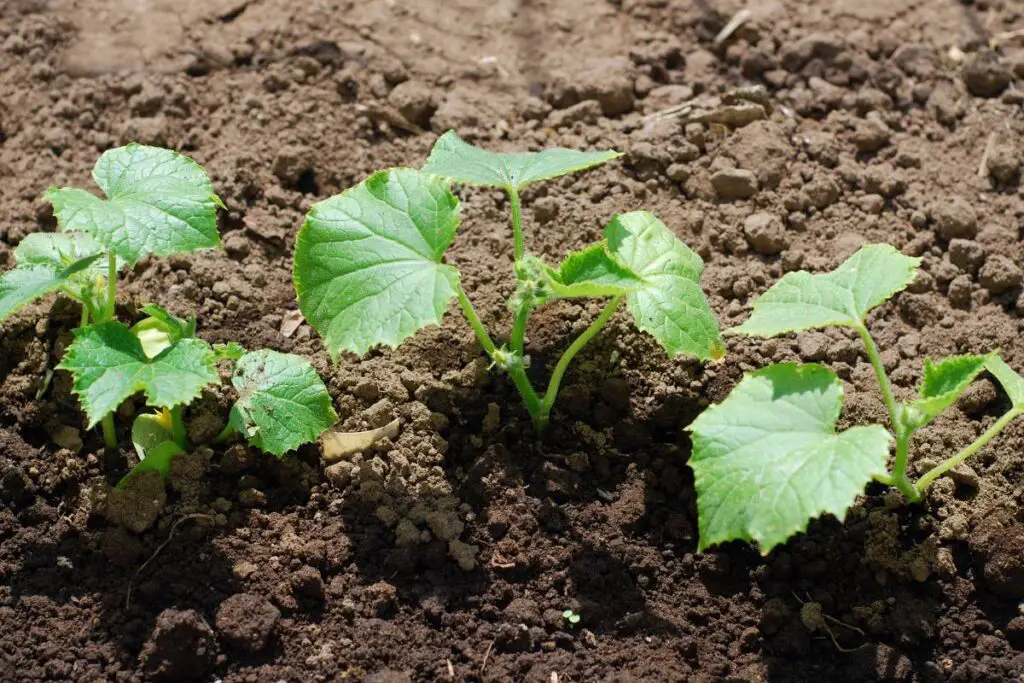
Before you transplant the seedlings, you need to know the right time to transplant them.
There are two situations where you will transplant the cucumbers:
- Transplanting the seedlings or starter plants in the garden from the pot.
- Transplanting the plants from one pot to another one.
In either case, timing is of utmost importance.
Cucumbers should be shifted when they are growing actively.
Since it will be the cucumbers’ growing season, they will overcome the easily, provided you care for them and meet their requirements well.
When transplanting the cucumbers, keep an eye on the weather outside.
It should be done when the weather is warm.
When transplanting the seedlings in the ground, the soil temperature must be at least 65 to 70°F during the day and 60°F at night.
The soil temperature will rise 2-3 weeks after the last spring frost.
So, check the soil temperature using a soil thermometer.
When starting the seeds indoors, sow them 4-6 weeks before the last frost.
When the soil temperature rises to 70°F, the seedlings will get ready to be transplanted.
Another thing to consider regarding timing is the transplants’ age and condition.
The right time to transplant the cucumbers is when the seedlings become 3 to 4 weeks old.
By 3 to 4 weeks, the seedlings should have:
- 2 cotyledon leaves
- Two fully-grown real leaves
- An emerging third set of leaves
- A fresh dark look
- No flowers
Before transplanting the seedlings outside, harden them off.
Preparing the cucumber seedlings for transplanting
Once you have selected the right time, prepare the seedlings for transplanting the young plants.
Preparation requires hardening off the plants before shifting them outside.
One week before the transplantation, start hardening them.
Expose them to the outdoor temperatures slowly. Begin with one hour, and slowly increase the timing to 4-6 hours daily.
Since the plant will stay outside, it needs acclimation to recover from stress and transplant shock.
Here is a detailed guide for preparing the cucumber seedlings and hardening them:
- Begin hardening the cucumbers one week before transplanting. The seedlings should be around 2 inches tall and have the first set of true leaves.
- When the weather starts warming up after the last frost, take the seedlings outside in a place with indirect sunlight for 1-2 hours.
- Bring them inside, and again take them outside the next afternoon and keep them under the full sun for 2-3 hours.
- On the third day, increase the sunlight exposure to 4 hours and then take them inside.
- Gradually increase the exposure to 4 to 6 hours from the next day.
- Maintain consistently moist soil before you take the seedlings outside for hardening.
- Keep the seedlings under full for the entire day on the fifth day. Please bring them back after sunset.
- On the sixth, let the seedlings stay outside all day and night.
- The cucumbers will be prepared to be transplanted outside on the last day.
Selecting an ideal location
You need to select an ideal planting site for transplanting the cucumbers.
Find a location that receives at least 6-8 hours of direct sunlight daily.
There should be enough space for the cucumbers to grow without obstructions like tall trees or walls.
However, if your site receives too much direct sunlight for over 10 hours, these tall trees and walls will benefit.
They will protect the seedlings from intense sunlight and hot weather.
Preparing the soil for the transplants
You can grow cucumbers in any soil.
But in that case, you will face problems like lesser yields, late germination, overwatering, or lack of nutrients.
Cucumbers need well-drained, loamy, nutrient-rich soil with a 6.0 to 6.5 pH level.
Along with that, the soil temperature needs to be at least 65 to 70°F.
That is why soil preparation is an essential step during cucumber planting.
The first step for preparation is to solarize the soil if it hasn’t warmed up yet after the last frost.
Cover your garden with black plastic the whole day for a few days or weeks.
Now, make it ideal for cucumber growth.
Dig around 25 to 30 cm of the topsoil and add organic matter.
It will improve the soil’s drainage, fertility, and pH level.
For better aeration, add some beneficial earthworms.
They will keep the soil aerated and also add nutrients to the soil.
Depth and spacing guidelines
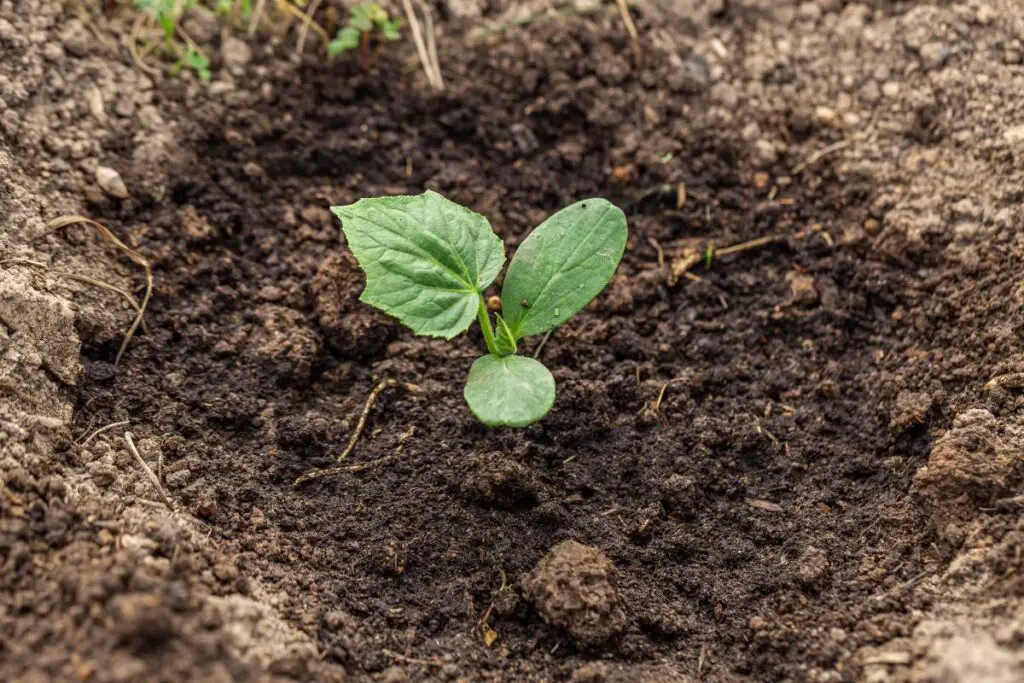
Knowing the correct depth and spacing leads to the healthy growth of the cucumber plants.
While digging holes for the transplants, maintain proper depth and distance for them.
The ideal depth for the transplants is ½ to 1 inch.
This depth will allow the plant to have a robust root system that can hold the plant in place.
Do not plant the cucumbers too deep, as that will bury the stem, exposing it to excessive moisture and rotting.
At times, the transplants can become slightly leggy.
In that case, you can plant them only 1.5 inches deep, but not more than that.
The spacing between the cucumbers will differ based on ground planting, trellis planting, vine varieties, and bush varieties.
When transplanting the seedlings to the ground without any trellis, dig holes 3 feet apart for the vine varieties.
For the bush varieties, keep 1 foot of distance.
If you are using a trellis, dig holes for transplants 6 to 12 inches apart at the base of the trellis.
This space is essential for the plant and roots for good growth, enough air circulation and breathing, and no pests and diseases.
Transplanting the cucumber seedlings: Step-by-step guide
Here is a brief guide to transplanting the seedlings:
Choose a day
First, choose an overcast day or late afternoon to transplant the seedlings to the garden.
Such weather is significant because it cannot expose the seedlings to direct sunlight for some days.
Even if you have hardened them, they still need some time to get exposed to direct sunlight.
Looking for gardening supplies? We have tested 100's of products before recommending them to you guys. Check out our best pick below:
| Image | Gardening Supplies | Best Price? |
|---|---|---|
 Top
Top Top
Top | Raised Garden Bed Kit | Check On Amazon |
 | XLUX Soil Moisture Meter, Plant Water Monitor, Soil Hygrometer Sensor for Gardening, Farming, Indoor and Outdoor Plants, No Batteries Required | No Results |
 Top
Top Top
Top | 82 Pcs Garden Tools Set and Extra Succulent Tools Set | Check On Amazon |
 | Joeys Garden Expandable Garden Hose with 8 Function Hose Nozzle, Lightweight Anti-Kink Flexible Garden Hoses, Extra Strength Fabric with Double Latex Core, (50 FT, Black) | No Results |
 Top
Top Top
Top | Dual Chamber Compost Tumbler | Check On Amazon |
 Top
Top Top
Top | Sunnyglade Plant Stakes | Check On Amazon |
 Top
Top Top
Top | Organic Cold Pressed Neem Seed Oil | Check On Amazon |
 Top
Top Top
Top | Mighty Mint Gallon :-Insect and Pest Control Peppermint Oil | Check On Amazon |
 Top
Top Top
Top | Scotts DiseaseEx Lawn Fungicide | Check On Amazon |
 Top
Top Top
Top | Jacks Classic 20-20-20 All Purpose Fertilizer | Check On Amazon |
 Top
Top Top
Top | 30,000 Seeds Pollinator Attracting Wildflower Mixture | Check On Amazon |
 Top
Top Top
Top | Survival Vegetable Seeds Garden Kit-Over 16,000 Seeds | Check On Amazon |
Prepare the seedlings
Before you move the seedlings from the pot, moisten them a bit.
Moistening the soil and seedlings slightly will make removal from the pot easier without falling apart.
At 3 weeks, the seedling roots will not overgrow but will become dense enough to keep the soil mixture in place.
Recheck the soil quality
Usually, the soil preparation I explained earlier is done in the fall.
If the soil degrades again before planting, dig it up and prepare it again one week before planting.
The soil must be well-drained, loamy, and nutrient-rich.
Amend the beds with organic matter like aged manure, homemade compost, and peat moss.
Plant the seedlings
Dig holes for the seedlings with proper depth and spacing.
Slowly take out the plant from the current pot or germination tray.
Without disturbing the roots and the soil around, plant them 1 inch deep and 3 to 4 feet apart in the ground.
Plant them 6 to 12 inches apart for trellising at the base of the trellis.
If the seedlings have become leggy, plant them 1.5 inches deeper, but do not go too deep.
Water the seedlings
Once you have finished planting the seedlings, water them enough for the first couple of days.
Adequate moisture will allow them to prevent transplant shock.
Train the seedlings
Once the seedlings start growing vines, train them to grow up the trellis.
With vertical gardening, you will receive high-density crops in a smaller space.
Cucumbers are fast-growing plants.
Instead of waiting for the cucumbers to grow vines, pre-install the trellis and plant the seedlings at the base.
Installing a trellis after the plant starts growing can accidentally damage the roots and stems.
Transplanting seedlings into containers
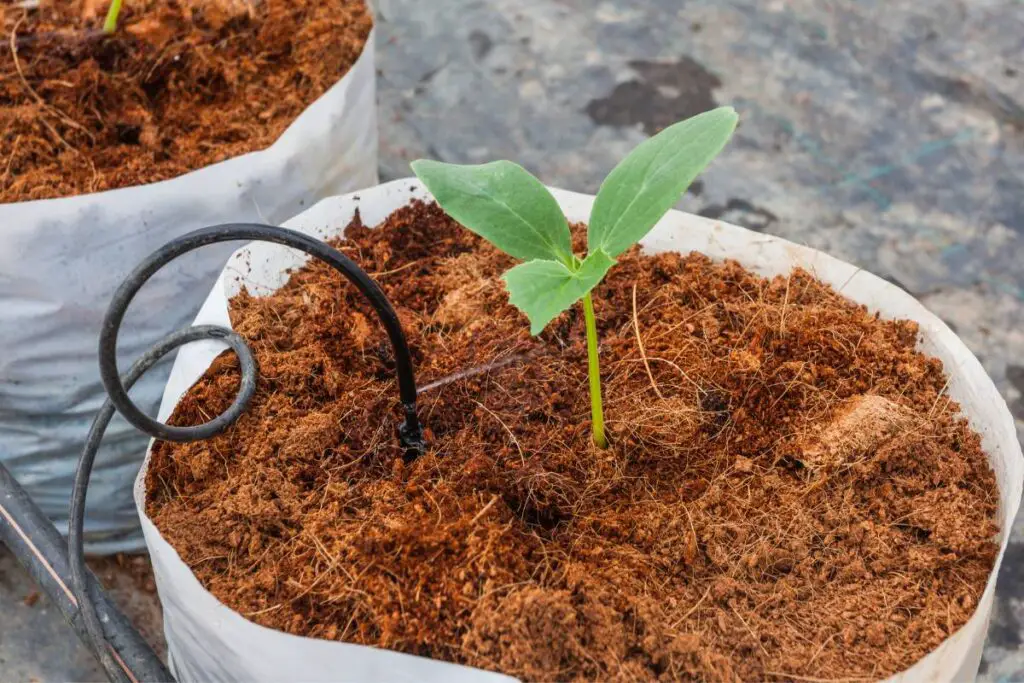
You can even transplant the seedlings into the pots.
Many people grow them in pots and keep them outside in warm weather for adequate sunlight.
It is advantageous for colder zones where you must bring them inside in the winter.
First, choose a pot at least 12 inches deep and wide for the cucumber vines and roots to grow comfortably.
Install a trellis or put the pot near a fence to support the vines.
Fill the pot with the ideal soil mix.
For instance, I use 50% each of compost and soil and make an ideal hole 1 inch deep.
Another recommended recipe is a mixture of 33% tilled soil, sand, and vermicompost.
Remove the cucumber from the old pot slowly, making sure not to disturb or hurt the roots.
Place the young plant in the new pot in the hole and gently pat down the soil around it.
Now, water the plant thoroughly and place the pot in an ideal location in your garden.
Please protect it from direct sunlight for the first couple of days.
Do not fertilize it now because you have already added organic matter to the soil for nutrition.
Once it reaches a few inches, you can start fertilizing.
The steps of transplanting the starters from the market are the same, whether in the pots or the ground.
Watering and care immediately after the transplantation
After transplanting the seedlings, please provide enough water to help them fight the transplant shock.
Watering should be done immediately after the transplantation and regularly after that.
But water them correctly.
If they are in pots, water them enough until the excess water starts coming out of the drainage holes.
It ensures the water has reached the roots.
As for the ground, there is no such way to confirm it.
So, water them enough or go for drip irrigation.
Drip irrigation ensures the plants receive enough water to reach the root system.
While watering, ensure the soil remains evenly moist but not wet or soaked, but there should not be any pool of water around the plant.
Transplanting the cucumbers will give them a shock.
Over that, overwatering them can lead to root rot and plant death.
Add an inch layer of mulch around the plants to maintain moisture and prevent overwatering.
It will keep the moisture trapped in the soil and retain it.
If you notice signs of wilting or stress, give them more water and ensure it receives enough sunlight.
It will make them bounce back to normal.
With constant care and maintenance, the transplants will grow well and provide flowers and fruits when the time arrives.
Protecting the cucumber transplants in their new environment
Even if you have hardened the transplants, they are still young.
You must protect the transplants for the first few weeks of transplanting until they adjust to their new environment.
Here are some ways to protect the seedlings, prevent any shocks, and help them get adjusted to the new environment:
Do not disturb the roots
The cucumber roots do not like to be disturbed.
If the roots are safe, the plants will quickly adjust to the new environment.
However, it is impossible when you are transplanting them.
One best way is to transplant the plant with the soil lump around the roots.
You might have to dig a bit deeper, like 1.5 to 2 inches deep.
It will stop you from moving or touching the root system.
Use a root stimulator
Using a bit of root stimulator helps the roots grow well, and the plant adjusts to the new environment faster.
You can get a formulated liquid called a root stimulator.
Mix it with water and pour a bit around the plant base.
It will stimulate the root system and encourage strong and healthy roots faster.
If the roots are slightly affected during the transplantation, the liquid will recover them and encourage them to adjust to the new environment.
Make the soil level the same as the seedlings had before
The cucumber seedlings will adjust to the new environment when they receive the same care and environment after transplanting.
It includes keeping the roots as they were, using ideal soil, providing enough moisture and light, and keeping the soil level as before.
When the soil level changes by burying the plant too deep or shallow, the roots can get disturbed, and the plant will suffer to adjust.
So, take note of the soil level to avoid stress. Also, keep the soil around the root system while transplanting.
Provide shade for the first few days
Even if the young plants are hardened before the transplantation, you must protect them from the first few days.
Excessive sunlight will dry them out and stress them. So, provide a bit of shade for a couple of days.
Once the plant is established, remove the shade.
Keep the soil moist before transplanting the seedlings
When you transplant the cucumbers, the roots may get damaged.
As a result, they fail to function until recovery and will not stand in conditions where the soil is dry.
To keep them hydrated, saturate the soil when digging them up from the pot.
It will ensure the roots have enough moisture and don’t get dry, encouraging quick adjustment, recovery, and establishment of the roots after 1-2 weeks.
Protect it from strong winds
Along with sunlight, you also have to protect them from strong winds outside.
The plants are not strong and well-established yet.
Strong winds can stress them while they are still recovering from the transplant shock.
Put up some wind barrier, for example, planting beside tall trees or a wall, using a wind mesh if you have installed a trellis, or placing some cinder blocks so the wind doesn’t reach the plants.
It will keep the plant from stress and help them adjust faster.
Replant the transplants soon after removing them
When you dig out the young plants from the pot, replant them as soon as possible.
Keeping them out for too long will dry out the roots, and the plants will take a lot of time to adjust to the new environment.
Immediate replanting means the area where you want to transplant the seedling should already have holes dug for them.
Immediate replanting will reduce the stress and chances of transplant shock and increase the plants’ chances of adjusting to the new environment faster.
Mulch the soil to keep it moist
When you prepare the soil for transplantation, it will remain exposed to sunlight and air.
As a result, the soil can dry out too much and harden off.
When you plant new plants, they might not receive enough moisture from the soil.
Even after you water them enough, it will take time for the water to penetrate the soil and moisten them thoroughly.
Adding a thick layer of mulch will protect the soil surface from sun and wind and prevent it from drying up too much.
When the mulch breaks down, it will add necessary nutrients to the soil and become perfect for cucumber growth.
And with enough nutrients and moisture, the plants will quickly adjust to the new environment.
Common challenges and troubleshooting tips for cucumber transplants
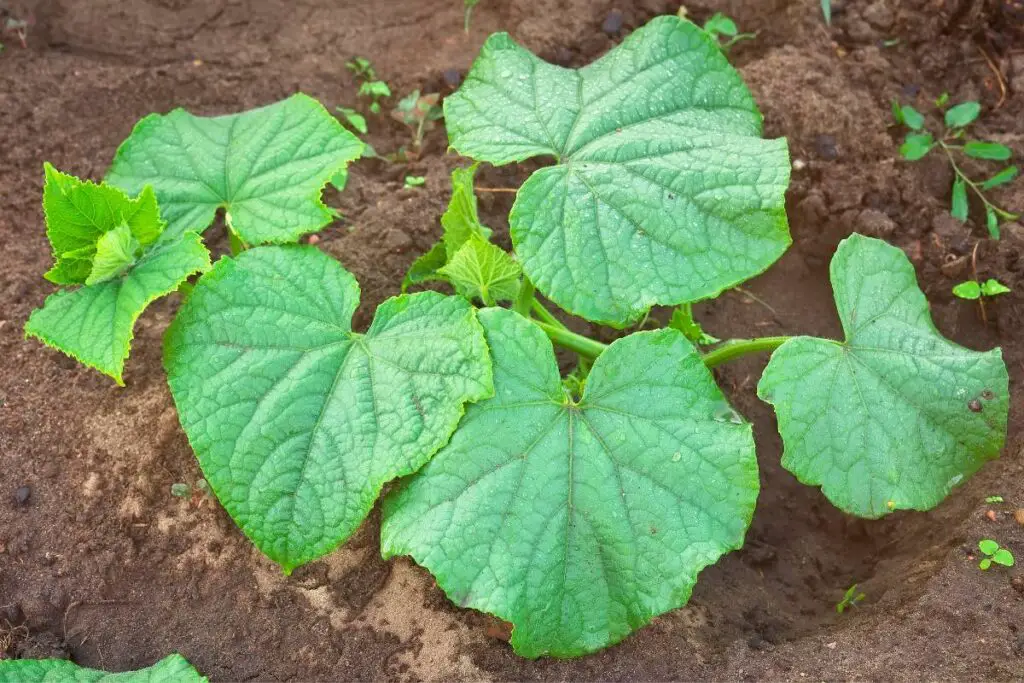
You will face a few issues since you are disturbing the cucumber’s root system and interrupting its development by transplanting them.
These issues are the result of transplant shock or lack of care post-transplant.
But don’t worry; you can help the plant recover with a few troubleshooting steps.
Here are some signs of transplant shock:
Transplants are wilting
The transplants wilt due to a lack of hardening, damage during the transplantation, or lack of watering.
When you start the seeds indoors, they are grown under controlled environments.
They are not exposed to harsh outdoor elements like direct sunlight, wind, or extreme temperatures.
When you take them outdoors without acclimating, they suddenly get exposed to the outdoor elements and get badly stressed.
It will further damage the plants’ development.
You must harden them by gradually exposing them to the outdoor elements.
The next reason for the wilting is damage during the transplant, for example, broken or bent vine or root damage.
If this happens, the transplants will look sad and wilted.
If there is no damage, the seedlings are too close, and the roots are entangled.
To avoid these situations, be gentle while transplanting the cucumbers.
To avoid root damage, avoid removing the soil lump from around the root.
To prevent root entanglement, plant them at least one foot apart from each other.
Maintain a 3-6 feet distance between them for the best results.
The last reason is the lack of watering.
After transplanting the seedlings, water them enough to let the moisture reach the roots.
Otherwise, the plants will wilt due to lack of moisture.
Check the soil’s moisture level and water them whenever the top few inches have dried.
Transplants are dying
The reasons are the same – lack of hardening and too much or too little moisture.
Always harden the young plants before transplanting them outside.
Provide adequate moisture after transplantation so that it reaches the roots.
But do not overdo it. The soil needs to stay evenly moist and not wet.
The plants are still delicate and cannot recover from overwatering. They will ultimately start rotting and die.
Check the soil always before you water them.
If they are in pots, water the plants until the excess drains out of the pot. In the ground, water them deeply and keep the moisture in check.
Consider drip irrigation in ground-level planting for better results.
Post-transplanting maintenance: Fertilizing and pruning
After transplanting the young seedlings from indoors to outdoors, the plants need special care and maintenance, at least for the first few days.
After that, you must provide them with regular care for healthy growth and development.
Fertilization
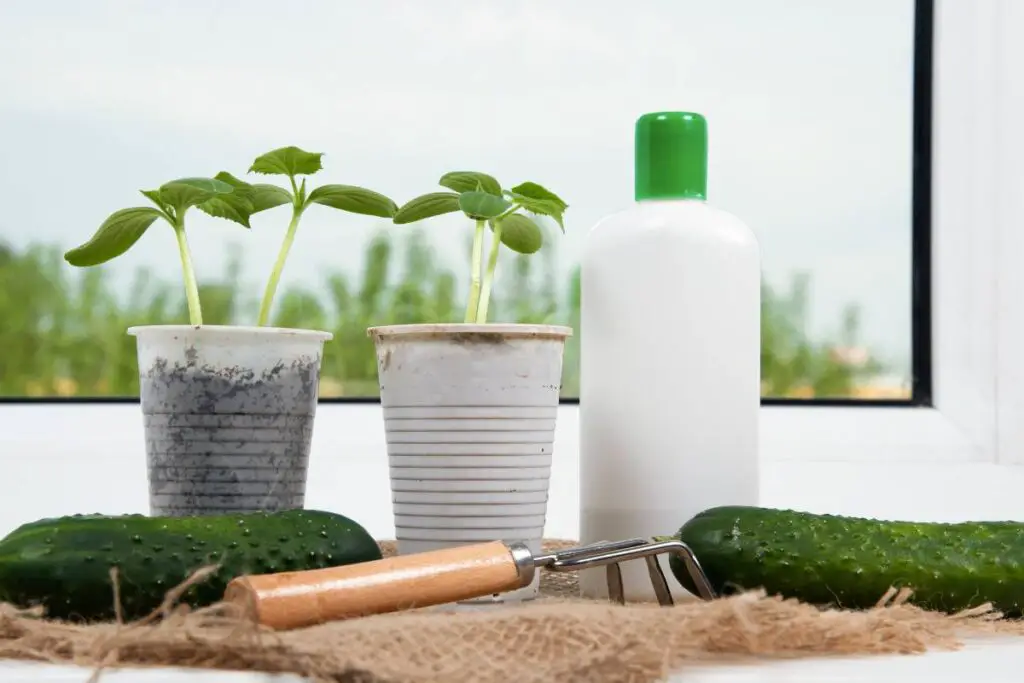
Post-transplanting, you do not have to fertilize the cucumbers immediately.
Start this after a month when the transplants become a few inches tall.
Since you will add organic matter during soil preparation before planting, the soil is already nutritious for the transplants.
Though you can choose any fertilizer, certain fertilizers suit the plant better at different growth stages.
For instance, nitrogen-rich fertilizers are needed for leaf growth in the early stage.
In contrast, phosphorus-rich fertilizers are essential to promote flowers and fruits in later growth.
Use a balanced liquid fertilizer with NPK 10-10-10 or a fertilizer with low nitrogen and high potassium and phosphorus, for example, NPK 2-3-6 or 3-6-6.
You can try organic fertilizers like worm castings, bone meal, mustard cake, or sea meal.
Pruning
Pruning is done when the cucumber transplants grow slightly bigger and grow too many leaves.
Excessive leaves do not allow the plant to focus on making flowers and fruits.
Sunlight cannot reach all parts of the plant, and there is a lack of airflow due to the overgrowth.
Pruning some leaves will encourage the plant to focus on flowers and fruits, allow sunlight to reach every plant part, and enhance air circulation and breathing.
Prune about a third of the plant’s leaves at the bottom and very few at the top.
Please don’t overdo it; that will stress the plant, leading to other issues.
Harvesting and Beyond Maximizing yields from the transplanted cucumber plants
Once you have provided enough fertilizers after transplanting, it is time to examine the plant growth and wait to harvest the tasty cukes.
The cukes will be ready for harvest within 50 to 70 days of transplanting.
Correct transplantation is vital in the plant’s growth and fruit production.
If the plant is healthy and stays fine throughout the growth, the cukes will be healthy and fresh during harvest.
So, make sure that the seedlings are ready for transplantation.
If the plants are not strong enough, they will grow weak.
They must have at least two to three true leaves.
With consistent care and watering, the transplants will soon grow into big healthy plants.
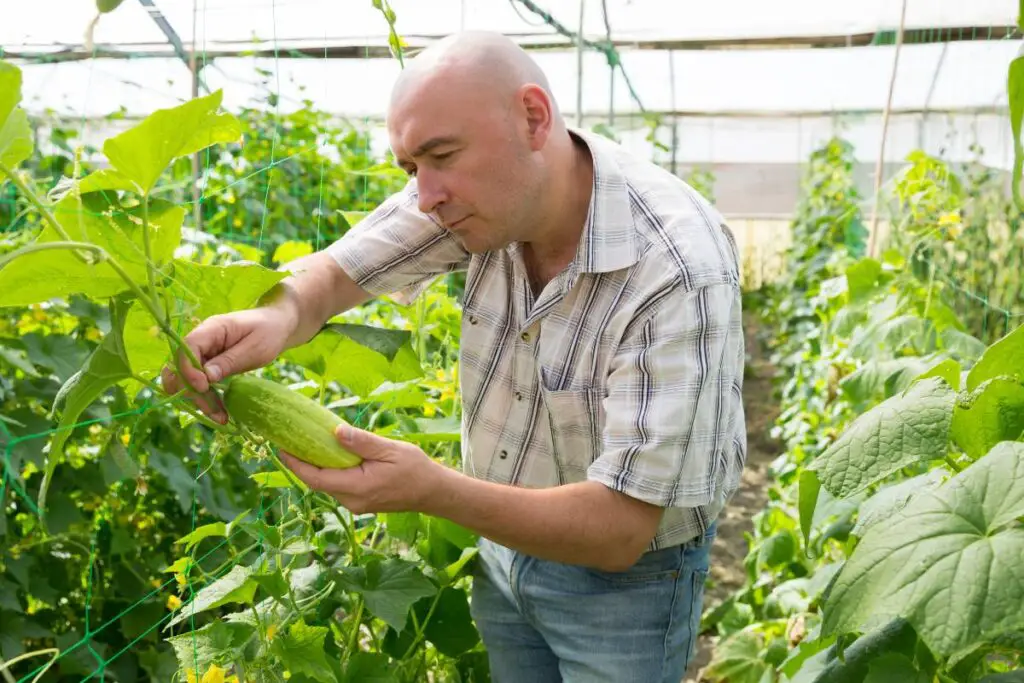
To maximize the yield in the cucumbers:
- Make sure to plant the transplants in the ideal location. They must receive at least 6 to 8 hours of sunlight per day.
- Amend the soil with organic matter before transplanting them.
- Plant the cucumbers 1 inch deep and maintain at least a 1-foot distance between each transplant, and 3 to 4 feet for the best performance.
- Fertilize them after one month, every 2 weeks for 8 weeks.
- Water them regularly whenever the top few inches have dried.
- Protect them from extreme temperatures or take them indoors.
The cucumber’s mature size varies based on the variety – the picklers grow 2 to 4 inches, and the slicing’s mature size is 6 to 9 inches, and sometimes 10 to 12”.
When the cucumbers reach the desired size and become thick with a rough or bumpy texture, it is time to pick them up.
During the peak season, check and harvest the cucumbers every day or every alternate day.
Leaving 1 to 1.5 inches of the stem, cut the cucumbers. Avoid twisting or pulling them, as that will hurt the plant.
Final thoughts
Cucumber transplants will do well if you transplant them carefully and adequately care for these young plants. Many gardeners do not recommend transplanting them because the roots of the cucumbers are sensitive and will react even to the slightest damage. That is why gardeners grow them directly on the ground or keep them in bigger pots until the roots get well-established.
However, you can still transplant them without disturbing the roots. Take the plant out, and replant it in the garden or another pot without removing the soil lump around the roots. After transplanting, please provide enough moisture to help them recover from the transplant shock. Keep checking the plant after transplanting to see if it is doing well or facing any stress.
Monitor for pests and diseases and take immediate actions, like isolating the plant, identifying the problem, spraying some neem oil, insecticides, fungicides, etc. Keep them healthy, as nourishing plants can resist infestation much more than weak plants.
Will the transplants need support?
Although it won’t be necessary, it is better to provide some support. The cucumber vines can grow long and keep crawling over the ground. So, a trellis won’t support the vines and help them grow without any issues.
How to avoid pests and diseases in the early season?
Cover the garden with insect netting, add mulch, or use trap crops to deter cucumber pests. For active infestation, insecticide and fungicide treatment will help.
Reference: Cucumber Wikipedia
